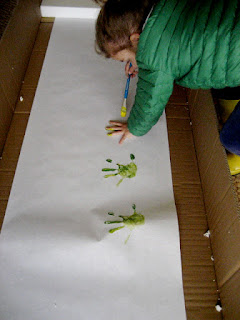 |
| The artists review photographic documentation of past Art + Nature activities |
For our sixth Art + Nature afternoon we gave special attention to a prominent species found throughout the Presidio: the Eucalyptus tree.
Though bright and sunny, it was a cold and windy afternoon in San Francisco. Entering the forest, we saw remnants of the previous day's rain. The sand was still wet and a small stream running along the path remained.
 Free flowing water streams across the foot-path |
Delighted, the artists investigate and articulate how water interacts with the surrounding landscape. For example, they noticed that the water moved underground as well as above ground; water takes the path of least resistance.
We identify eucalyptus trees and begin to explore their effects. We collect different parts of the tree that have fallen to the ground including leaves, branches, seed pods, and curly strands of bark.
We identify eucalyptus trees and begin to explore their effects. We collect different parts of the tree that have fallen to the ground including leaves, branches, seed pods, and curly strands of bark.
 |
| Left: Pulling bark as it dangles from a branch Right: "Look! The bark came from this tree." |
 |
| Stretching fallen Eucalyptus bark |
Admiring the swaying canopy above, listening to sounds of whipping wind and soft music we muse:
"Perhaps the trees are dancing to the music?"
"No, they are waving at us," the children reply.
The trees are waving, we agree.
We return to the art studio with a collection bag full of Eucalyptus tree treasures.
The trees are waving, we agree.
We return to the art studio with a collection bag full of Eucalyptus tree treasures.
First, the artists explore the possibilities of using Eucalyptus bark as a drawing surface.
Oil pastels glide on smoothly and saturate the bark with pigment.
Applying crayon over the pastels creates a waxy contrast.
Chalk creates bright patches of color though with less permanence than both crayon and oil pastel.
 |
| Mixing colors on 'nature's paper' |
 |
| Creating multi-colored prints |
 |
| Using Eucalyptus seed pods as stamps and the leaves as stencils and stamps |
 |
| Using a textured paint roller |
 |
| Rolling out the 'train tracks' |
 |
| Here the artist uses a tree branch to apply paint |
The artists delve deeper into the mixing of colors while witnessing the effects of various brushes on multiple surfaces. Sharing tools, work spaces, and paint provides opportunities to engage each other's artwork and learn together.
Here are some of the completed art pieces from our Eucalyptus themed afternoon adventure:
 |
| A chain of colorful leaves |
 |
| Using branches as paint brushes creates an interesting Pollack-esque effect |
 |
| This finished painting features a Eucalyptus leaf imprint |
 |
| Artwork created with both paper and bark accompanied by the longest Eucalyptus leaf we found |




















